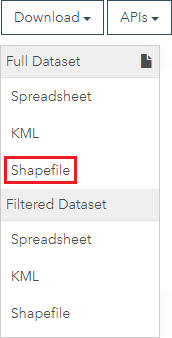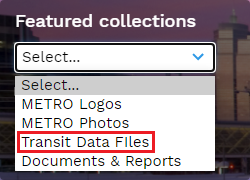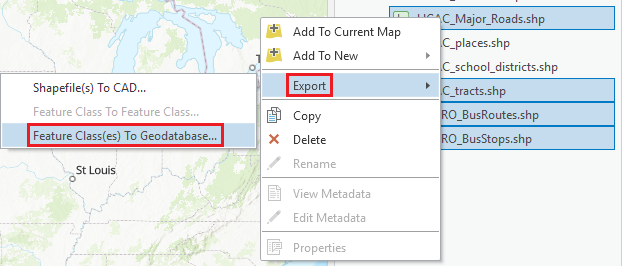TABLE OF CONTENTS
| Table of Contents |
|---|
| Info |
|---|
This guide was created by the staff of the GIS/Data Center at Rice University and is to be used for individual educational purposes only. The steps outlined in this guide require access to ArcGIS Pro software and data that is available both online and at Fondren Library. The following text styles are used throughout the guide: Explanatory text appears in a regular font.
Folder and file names are in italics. Names of Programs, Windows, Panes, Views, or Buttons are Capitalized. 'Names of windows or entry fields are in single quotation marks.' "Text to be typed appears in double quotation marks." |
| Info |
|---|
The following step-by-step instructions and screenshots are based on the Windows 10 operating system and ArcGIS Pro 2.5.0 software with an Advanced license. If your personal system configuration varies, you may experience minor differences from the instructions and screenshots. |
This course will teach you how to download, evaluate, and prepare GIS data from public online sources and set up a project in ArcGIS Pro.
...
There are three ways of obtaining the tutorial data. The best option for getting the full GIS project experience is to follow Option 1 and learn how to download data from online GIS data portals. You will also gain exposure to the best GIS data websites for the Houston region. If you have limited time or if any of the data provider websites are not functional, you may get a downloaded version from the computer Before beginning the tutorial, you will copy all of the required tutorial data onto your Desktopdownload an identical version directly from the computers in the GIS/Data Center (Option 2) or online from this wiki (Option 3). Follow the applicable set of instructions below depending on the particular computer you are using.
...
If you choose to download the tutorial data from the source websites and to practice finding and obtaining data from online sources, follow these instructions:
COHGIS Open Data Portal
The COHGIS (City of Houston GIS) Open Data Portal website provides over 100 data sets including administrative boundaries, amenity locations, transportation routes, crime, and flooding. For this tutorial, we will download population and housing data from the 2010 census, which has been aggregated to super neighborhood boundaries.
...
Whenever you see a URL that ends in opendata.arcgis.com, you will know
...
the instructions below.
H-GAC GIS Census Data
In this case, we are looking for census data by super neighborhood. To learn more about super neighborhoods, visit the City of Houston Super Neighbhorhoods webpage.
...
The Houston-Galveston Area Council (H-GAC) is the 13-county Metropolitan Planning Organization (MPO) for the Houston region. Federal legislation requires that an MPO be designated for each urbanized area with a population greater than 50,000 people (as established by the U.S. Census Bureau) in order to conduct long-range metropolitan transportation planning and be eligible for Federal funding for transportation projects. Their mission to conduct carry out metropolitan transportation planning , means that MPOs are a great source of data on topics such as demographics, employment, land use, transportation, and environmental conditions and most of these topics are well-suited towards GIS analysis.
Most of the data provided on the H-GAC portal is not originally created by the H-GAC, but rather. Instead, the data is either aggregated from multiple municipalities up to the 13-country region, or clipped from the entire country or state down to the 13-county region. For this tutorial, we will download population and housing data from the 2010 census, which has been aggregated to census tract boundaries.
- Using a web browser, search for "h-gac gis for "hgac census" and select the result as shown below or or go directly to: httphttps://www.h-gac.com/rds/gis-data/gis-datasets.aspx.
- Under the Dataset Categories section, click the Transportation button to filter the results by subject.
- Under the Datasets section, click Major Roads.
- Click Download Dataset.
- Click the blue Download button.
- census-data.
- Under the '2010 Decennial Census Data' section, in the 'Ethnicity' column, click Download Boundary files.
- Click the blue Download button.
- At the bottom of your browser window, you should see the Census2010_Redistricting_Data_Shapefiles.zip compressed folder being downloaded.
H-GAC GIS Datasets
- Using a web browser, search for "hgac gis" and select the result as shown below or go directly to: https://gishub-h-gac.hub.arcgis.com/.
- In order to see all of the data available in the catalog, click in the 'Search data' box and, without typing anything, press Enter.
Feel free to browse through the available data and filter by categories on the left. When you are finished exploring, you will download major roads data.
- At the top of the website, in the 'Search" box, type "roads" and click the HGAC Major Roads result directly beneath the search box.
- Click Download > Full Dataset Shapefile.
- At the bottom of your browser window, you should see the HGAC_Major_Roads-shp.zip compressed folder downloaded.
Houston METRO Downloads
The Houston METRO website provides GIS data for the public transit system in Houston provided by METRO. While the same data is also available on the H-GAC Regional Data Hub, it is often For this tutorial, you will need the bus stops and bus routes data, which is included in the downloadable zip-file containing all of the GIS data available on the site. To obtain this data:
- Using a web browser, search for "houston metro gis" and select the result as shown below or go directly to: https://www.ridemetro.org/Pages/NewsDownloadsDigitalAssets.aspx.
- Scroll down to the bottom of the webpage and locate the Zipped Data Files section.
There are two links in this section that look promising: METRO GIS Data Layers and METRO GIS Data. From the perspective of a GIS user, there is nothing about those particular link names that is helpful in deducing which link to download. After testing both downloads, we determined that the Metro GIS Data download contains only the METRO service boundary, while the METRO GIS Data Layers download contains
- Click METRO GIS Data Layers to download.
- and select Get Started.
- From the left "Featured collections" dropdown select Transit Data Files.
- Select Shape files.
- Click Bus Routes - shape file (do not check the box) and click the blue Download button.
- Click outside of the download pop-up window to close it.
- Click Bus Stops - shape file (do not check the box) and click the blue Download button.
- At the bottom of your browser window, you should see both the RS2688_Bus Stops - shape file.zip and RS2689_Bus Routes - shape file.zip compressed folders downloaded.
COHGIS
...
Though it is not used in this course, the Harris County Appraisal District (HCAD) Public Data is another great online source that provides similar data such as highways, utilities, and water districts COHGIS (City of Houston GIS) Data Hub provides over 200 data sets including administrative boundaries, amenity locations, transportation routes, crime, and flooding and is available at: httphttps://cohgis-mycity.opendata.arcgis.com/. (Whenever you see a URL that ends in opendata.arcgis.com, you will know that you are visiting a standard ArcGIS Hub, which are commonly used by government entities for sharing GIS data.)
HCAD
The pdata.hcad.org/GIS/index.htmlThe HCAD (Harris County Appraisal District (HCAD) Public Data website is another another great online source that provides similar data such as highways, utilities, and water districts of Houston data related to land parcels and other boundaries and is available at at: httphttps://pdata.hcad.org/GIS/index.html/hcad-online-services/pdata/.
OPTION 2: Accessing tutorial data from Fondren Library using the gistrain profileAnchor Option 2 Option 2
| Option 2 | |
| Option 2 |
If you are completing this tutorial from a computer in Fondren Library and are logged in using the gistrain profile, follow the instructions below:
- In the taskbar at the bottom of the screen, click the File Explorer Application.
- In the Navigation pane on the left side of File Explorer, double-click GISData (\\smb.rdfFrom the Start menu, click Computer > gisdata (\\file-rnas.rice.edu\research\FondrenGDC) (RO:) > GDCTraining > 1_Short_Courses > Introduction_to_GIS_Data_Management > Downloads.
- To create a personal copy of the tutorial data, select all four zip folders and drag them into the IntroTutorialData Downloads folder onto in the DesktopNavigation pane.
- Close all windows.
OPTION 3: Accessing tutorial data online using a personal computerAnchor Option 3 Option 3
| Option 3 | |
| Option 3 |
If you are completing this tutorial from a personal computer, you will need to download the tutorial data online by following the instructions below:
| Info | ||
|---|---|---|
| ||
- Click Downloads.zip above
- Using a web browser, go to the Introduction to GIS short course webpage at: http://library.rice.edu/gis-intro
- At the bottom of the webpage, under the Resources section, click the Introduction to GIS – Tutorial Data link to download the tutorial data.
- Unzip the IntroTutorialData folder.
- Copy the unzipped IntroTutorialData folder to your Desktop or another location of your choice. Ensure that you note the file path of the location you have selected.
...
- Open your Downloads folder.
- Right-click the compressed Downloads folder and select Extract All....
- In the 'Extract Compressed (Zipped) Folders' window, click the Browse... button.
- On the left side of File Explorer in the Navigation pane, single-click the Downloads folder and click the Select Folder button.
- Uncheck Show extracted files when complete.
- Click Extract.
- Right-click the original compressed Downloads folder and select Delete.
Preparing the Downloaded Data for ArcGIS Pro
Once you have downloaded the Census and Major Roads data from H-GAC and the Bus Stops and Bus Routes data from Houston METRO and the SuperNeighborhoods and Freeways data from COHGIS, you should be able to find locate the data files in your Downloads folder.
- Open the Downloads folder.
- Ensure that you see the four folders shown below.
Notice You will see that all the files folders are compressed, or zipped, meaning they contain compressed files of data within them (you , which allows you to download a single ZIP file, instead of numerous individual files. You can tell a file folder is zipped when the file type 'Type' column reads “Compressed 'Compressed (zipped) Folder”). You will need to unzip the folders to be able to see the data inside them. To do that:
- In your Downloads folder, click in the gray space next to your file path at the top. This should highlight your file path. Right click and copy your file path.
- Click on one of the data files in your Downloads folder. Once it’s highlighted, right click on the file and select Extract All…
- For the file destination, right click and paste the file path that you copied in the first step.
- Click on the Extract button.
- Repeat this process for however many zipped data files you have.
Folder' and the folder icon has a zipper on it. In order to view and utilize the data within ArcGIS software, you will first need to extract, or unzip, the folders.
If you have 7-Zip installed or would like to install it for free:
- Select all four folders.
- Right-click any of the selected folders and select 7-Zip > Extract Here.
If you do not have 7-Zip installed:
- Right-click each zipped folder individually and select Extract All... and then click Extract.
Your data is now in an uncompressed Your data should now be in a file folder in its decompressed format and ready to be brought into ArcGIS Pro.
...
Creating a New Project in ArcGIS Pro
- From the Start menu, launch ArcGIS Pro.
- When ArcGIS Pro opens, under the Create a new project 'New' section, click the Blank project template Map template.
- In the 'Create a New Project' window, for Name, type "Intro".
- For Location, click the Browse... button to the right.
- In the 'Select a folder to store the project.New Project Location' window, click click Computer in the left column and click Desktop in the right column and click click OK.
- Click OK once again.
- Maximize the ArcGIS Pro application window.
- In the
...
- In the 'Create a New Project' Window, click OK.
- Maximize the ArcGIS Pro application window
Managing GIS Data
The full layout of the software will be covered in the Introduction to ArcGIS Pro tutoril. For now, all you will be using is the Catalog pane along the far right side of the application window.
- In the Catalog pane, click the arrow to expand Folders > Intro > Intro.gdb.
You will notice there is currently no data in the Intro project geodatabase that was automatically created when you created the Intro project. Over the next few steps, you will import the data you downloaded online from the Downloads folder to your project geodatabase.
Connecting to a folder
- In the Catalog pane, right-click Folders and and select Add Folder Connection.
Exploring GIS Data
Previewing GIS data metadata and features
Examining GIS Data Coordinate systems
Managing GIS Data
Copying feature classes between geodatabases
Converting shapefiles to geodatabase feature classes
Converting geodatabase feature classes to shapefiles
- In the 'Add Folder Connection' window, click Computer in the left column and single-click Downloads in the right column. Click OK.
- In the Catalog pane, expand Downloads and ensure it looks as shown below. (If you followed Option 3 for obtaining the tutorial data and downloaded the data from this wiki page, you will only see four shapefiles listed.)
Importing and exporting data in the project geodatabase
For this tutorial, we are working with vector data, which is a spatial data format that uses points, lines, and polygons to represent real features on the Earth's surface. Vector data is ideal for discrete themes with definite boundaries. A Feature Class is a vector storage format that represents a homogeneous collection of common features. There are two types of Feature Classes: a Shapefile feature class and a Geodatabase feature class. A Shapefile feature class is an open source format. Its file extension is .shp and its icon is green. A Geodatabase feature class is an Esri proprietary format. A Geodatabase feature class must be stored inside a Geodatabase (.gdb) and its icon is white. To better organize our project, we will import data into our Project Geodatabase.
All of the data you have downloaded is in the shapefile format. Since shapefiles and geodatabases are different file formats, you must convert the data.
- In the Catalog pane, hold down the Ctrl key and clickHGAC_Major_Roads.shp, HGAC_tracts.shp, METRO_BusRoutes.shp, and METRO_BusStops.shp to select all four shapefiles, as shown below.
- Right-clickHGAC_Major_Roads.shp and select Export > Feature Class(es) To Geodatabase....
Note that the Geoprocessing pane opens on top of the Catalog pane. To toggle between the panes, you can use the tabs at the bottom of the pane.
- Ensure your 'Feature Class To Geodatabase' tool parameters appear as shown below and clickRun.
- At the bottom of the Geoprocessing pane, click the Catalog tab.
- In the Catalog pane, right-click the Intro.gdb geodatabase and select Refresh.
- If necessary, expand the Intro.gdb geodatabase. Your project geodatabase should now contain four geodatabase feature classes: HGAC_Major_Roads, HGAC_tracts, METRO_BusRoutes, and METRO_BusStops, as shown below.
- In the Catalog pane, in the Folders section, right-click the Downloads folder connection and select Remove.
- In the Quick Access toolbar at the top of the application window, click the Save button.
- Close ArcGIS Pro.
...

























